Landslide Susceptibility Evaluation of Bayesian Optimized CNN Gengma Seismic Zone Considering InSAR Deformation
Abstract
:1. Introduction
2. Principles and Methods
2.1. Convolutional Neural Networks for Bayesian Optimization
2.2. Random Forests
2.3. Support Vector Machines
2.4. Technical Routes
3. Data Preparation and Analysis
3.1. Overview of the Study Area
3.2. Landslide Cataloging
3.3. Data Sources
3.4. Selection of Evaluation Factors
3.5. Independence Test
3.6. Evaluation Factor Analysis
4. Analysis of Evaluation Results
4.1. Results of the Vulnerability Evaluation
4.2. Evaluation Accuracy Analysis
5. Discussion
6. Conclusions
Author Contributions
Funding
Data Availability Statement
Acknowledgments
Conflicts of Interest
References
- Lukić, T.; Leščešen, I.; Sakulski, D.; Basarin, B.; Jordaan, A. Rainfall erosivity as an indicator of sliding occurrence along the southern slopes of the Bačka loess plateau: A case study of the Kula settlement, Vojvodina (North Serbia). Carpathian J. Earth Environ. Sci. 2016, 11, 303–318. [Google Scholar]
- Lukić, T.; Bjelajac, D.; Fitzsimmons, K.E.; Marković, S.B.; Basarin, B.; Mlađan, D.; Micić, T.; Schaetzl, R.J.; Gavrilov, M.B.; Milanović, M.; et al. Factors triggering landslide occurrence on the Zemun loess plateau, Belgrade area, Serbia. Environ. Earth Sci. 2018, 77, 519. [Google Scholar] [CrossRef]
- Zhuang, J.; Peng, J. A coupled slope cutting—A prolonged rainfall-induced loess landslide: A 17 October 2011 case study. Bull. Eng. Geol. Environ. 2014, 73, 997–1011. [Google Scholar] [CrossRef]
- Zhuang, J.; Peng, J.; Wang, G.; Javed, I.; Wang, Y.; Li, W. Distribution and characteristics of landslide in Loess Plateau: A case study in Shaanxi province. Eng. Geol. 2018, 236, 89–96. [Google Scholar] [CrossRef]
- Morar, C.; Lukić, T.; Basarin, B.; Valjarević, A.; Vujičić, M.; Niemets, L.; Telebienieva, I.; Boros, L.; Nagy, G. Shaping Sustainable Urban Environments by Addressing the Hydro-Meteorological Factors in Landslide Occurrence: Ciuperca Hill (Oradea, Romania). Int. J. Environ. Res. Public Health 2021, 18, 5022. [Google Scholar] [CrossRef]
- Chi, T.; Su, Y. Integrated System for Remote Sensing Monitoring and Assessment of Major Natural Disasters; China Science and Technology Press: Beijing, China, 1995. [Google Scholar]
- Moretto, S.; Bozzano, F.; Esposito, C.; Mazzanti, P.; Rocca, A. Assessment of landslide pre-failure monitoring and forecasting using satellite SAR interferometry. Geosciences 2017, 7, 36. [Google Scholar] [CrossRef]
- Tzouvaras, M.; Danezis, C.; Hadjimitsis, D.G. Small scale landslide detection using Sentinel-1 interferometric SAR coherence. Remote Sens. 2020, 12, 1560. [Google Scholar] [CrossRef]
- Tzouvaras, M. Statistical Time-Series Analysis of Interferometric Coherence from Sentinel-1 Sensors for Landslide Detection and Early Warning. Sensors 2021, 21, 6799. [Google Scholar] [CrossRef]
- Wasowski, J.; Bovenga, F.; Casarano, D.; Nutricato, R.; Refice, A. Application of PSI techniques to landslide investigations in the Caramanico area (Italy): Lessons learnt. In Proceedings of the Fringe 2005 Workshop; Application of PSI Techniques to Landslide Investigations in the Caramanico Area (Italy), Frascati, Italy, 28 November–2 December 2005; Volume 610. [Google Scholar]
- Guzzetti, F.; Reichenbach, P.; Ardizzone, F.; Cardinali, M.; Galli, M. Estimating the quality of landslide susceptibility models. Geomorphology 2006, 81, 166–184. [Google Scholar] [CrossRef]
- Cheng, T.; San, X.; Dong, W. A study of landslide distribution in loess area with InSAR. Hydrogeol. Eng. Geol. 2008, 25, 98–101. [Google Scholar]
- Carlà, T.; Tofani, V.; Lombardi, L.; Raspini, F.; Bianchini, S.; Bertolo, D.; Thuegaz, P.; Casagli, N. Combination of GNSS, satellite InSAR, and GBInSAR remote sensing monitoring to improve the understanding of a large landslide in high alpine environment. Geomorphology 2019, 335, 62–75. [Google Scholar] [CrossRef]
- Ge, D.; Dai, K.; Guo, Z.; Li, Z. Early Identification of serious geological hazards with integrated remote sensing technologies:thoughts and recommendations. J. Wuhan Univ. 2019, 44, 949–956. [Google Scholar]
- Manconi, A.; Kourkouli, P.; Caduff, R.; Strozzi, T.; Loew, S. Monitoring Surface Deformation over a Failing Rock Slope with the ESA Sentinels: Insights from Moosfluh Instability, Swiss Alps. Remote Sens. 2018, 10, 672. [Google Scholar] [CrossRef]
- Tzouvaras, M.; Danezis, C.; Hadjimitsis, D.G. Differential SAR Interferometry Using Sentinel-1 Imagery-Limitations in Monitoring Fast Moving Landslides: The Case Study of Cyprus. Geosciences 2020, 10, 236. [Google Scholar] [CrossRef]
- Xu, Q.; Dong, X.; Li, W. Integrated space-air-ground early detection, Monitoring and warming system for potentianl catastrophic geohazards. J. Wuhan Univ. 2019, 44, 957–966. [Google Scholar]
- Shi, X.; Xu, J.; Jiang, H.; Zhang, L.; Liao, M. Slope stability state monitoringandn updating of the outang landslide, Three gorges area with time series InSAR analysis. Earth Sci. 2019, 44, 4284–4292. [Google Scholar]
- Liu, B.; Ge, D.; Wang, S.; Li, M.; Zhang, L.; Wang, Y.; Wu, Q. Combining application of TOPS and scanSAR InSAR in large-scale geohazards identification. J. Wuhan Univ. 2020, 45, 1756–1762. [Google Scholar]
- Cai, J.H.; Zhang, L.; Dong, J.; Dong, X.; Liao, M.; Xu, Q. Detection and monitoring of post-earthquake landslides in jiuzhaigou using radar remote sensing. J. Wuhan Univ. 2020, 45, 1707–1716. [Google Scholar]
- Dai, C.; Li, W.L.; Lu, H.Y.; Yang, F.; Xu, Q.; Jian, J. Active landslides detection in Zhouqu county, gansu province using InSAR technology. J. Wuhan Univ. 2021, 46, 994–1002. [Google Scholar]
- Zhang, C.L.; Li, Z.H.; Yu, C.; Song, C.; Xiao, R.; Peng, J. Landslide detection of the jinsha river region using GACOS assisted InSAR stacking. J. Wuhan Univ. 2021, 46, 1649–1657. [Google Scholar]
- Li, M.; Zhang, L.; Dong, J.; Cai, J.; Liao, M. Detection and monitoring of potential landslides along Minjiang river valley in maoxian county, sichuan using radar remote sensing. J. Wuhan Univ. 2021, 46, 1529–1537. [Google Scholar]
- Zhou, D.; Zuo, X.; Xi, W.; Xiao, B.; Bi, R.; Xin, F. Early identification of landslide hazards in deep-cut alpine canyon using SBAS-InSAR technology. Chin. J. Geol. Hazards Prev. 2022, 33, 16–24. [Google Scholar]
- He, J.; Ju, N.; Xie, M.; Wen, Y.; Zuo, M.; Deng, M. Comparison of InSAR technology for identification of hidden dangers of geological hazards in alpine and canyon areas. Earth Sci. 2023, 1–20. [Google Scholar]
- Jiang, Z.; Zhao, C.; Yan, M.; Wang, B.; Liu, X. The Early Identification and Spatio-Temporal Characteristics of Loess Landslides with SENTINEL-1A Datasets: A Case of Dingbian County, China. Remote Sens. 2022, 14, 6009. [Google Scholar] [CrossRef]
- Zhou, P.; Deng, H.; Zhang, W.J. Landslide susceptibility evaluation based on information value model and machine learning method: A case study of lixian county, sichuan province. Geoscience 2022, 42, 1665–1675. [Google Scholar]
- Luo, L.; Pei, X.; Cui, S.; Huang, R.; Zhu, L.; He, Z. Combined selection of susceptibility assessment factors for Jiuzhaigou earthquake-induced landslides. J. Rock Mech. Eng. 2021, 40, 2306–2319. [Google Scholar]
- Zhang, Z.; Dang, M.; Xu, S.; Zhang, Y.; Fu, H.; Li, Z. Comparison of landslide susceptibility assessment models in Zhenkang County, Yunnan Province, China. J. Rock Mech. Eng. 2022, 41, 157–171. [Google Scholar]
- Li, Y.; Xu, L.; Zhang, L. Study on development patterns and susceptibility evaluation of coseismic landslides within mountainous regions Influenced by strong earthquakes. Earth Sci. 2023, 48, 1960–1976. [Google Scholar]
- Boussouf, S.; Fernández, T.; Hart, A.B. Landslide susceptibility mapping using maximum entropy (MaxEnt) and geographically weighted logistic regression (GWLR) models in the Río Aguas catchment (Almería, SE Spain). Nat. Hazards 2023, 117, 207–235. [Google Scholar] [CrossRef]
- Huang, W.; Ding, M.; Li, Z.; Zhuang, J.; Yang, J.; Li, X.; Meng, L.; Zhang, H.; Dong, Y. An Efficient User-Friendly Integration Tool for Landslide Susceptibility Mapping Based on Support Vector Machines: SVM-LSM Toolbox. Remote Sens. 2022, 14, 3408. [Google Scholar] [CrossRef]
- Huang, W.; Ding, M.; Wang, D.; Jiang, L.; Li, Z. Landslide susceptibility assessment along the Sichuan-Tibet transportation corridor based on layer adaptive weighted convolutional neural network. Earth Sci. 2022, 47, 2015–2030. [Google Scholar]
- Huan, Y.; Song, L.; Khan, U.; Zhang, B. Stacking ensemble of machine learning methods for landslide susceptibility mapping in Zhangjiajie City, Hunan Province, China. Environ. Earth Sci. 2022, 82, 35. [Google Scholar] [CrossRef]
- Kong, J.; Zhong, J.; Peng, J.; Zhan, J.; Ma, P.; Mu, J.; Wang, J.; Wang, S.; Zheng, J.; Fu, Y. Evaluation of landslide susceptibility in chinese loess plateau based on IV-RF and IV-CNN coupling models. Earth Sci. 2023, 48, 1711–1729. [Google Scholar]
- Hidayatul, M.U.; Rohmaneo, M.D. Landslide Susceptibility Spatial Modelling Using Random Forest Algorithm: A Case Study of Malang Regency. IOP Conf. Ser. Earth Environ. Sci. 2023, 1127, 012026. [Google Scholar]
- Gui, J.; Alejano, L.; Yao, M.; Zhao, F.; Chen, W. GIS-Based Landslide Susceptibility Modeling: A Comparison between Best-First Decision Tree and Its Two Ensembles ( BagBFT and RFBFT). Remote Sens. 2023, 15, 1007. [Google Scholar] [CrossRef]
- Teruyuki, K.; Koki, S.; Satoshi, N.; Takahashi, K. Landslide susceptibility mapping using automatically constructed CNN architectures with pre-slide topographic DEM of deep-seated catastrophic landslides caused by Typhoon Talas. Nat. Hazards 2023, 117, 339–364. [Google Scholar]
- Behnia, P.; Blais-Stevens, A. Landslide susceptibility modelling using the quantitative random forest method along the northern portion of the Yukon Alaska Highway Corridor, Canada. Nat. Hazards 2018, 90, 1407–1426. [Google Scholar] [CrossRef]
- Phong, T.; Phan, T.; Prakash, I.; Singh, S.K.; Shirzadid, A.; Chapi, K.; Ly, H.-B.; Ho, L.S.; Quoc, N.K.; Pham, B.T. Landslide susceptibility modeling using different artificial intelligence methods: A case study at Muong Lay district, Vietnam. Geocarto Int. 2021, 36, 1685–1708. [Google Scholar] [CrossRef]
- Wang, S.; Zhuang, J.; Zheng, J.; Fan, H.; Kong, J.; Zhan, J. Application of Bayesian Hyperparameter Optimized Random Forest and XGBoost Model for Landslide Susceptibility Mapping. Front. Earth Sci. 2021, 9, 712240. [Google Scholar] [CrossRef]
- Zhang, Y.; Xu, P.; Liu, J.; He, J.; Yang, H.; Zeng, Y.; He, Y.; Yang, C. Comparison of LR, 5-CV SVM, GA SVM, and PSO SVM for landslide susceptibility assessment in Tibetan Plateau area, China. J. Mt. Sci. 2023, 20, 979–995. [Google Scholar] [CrossRef]
- Wu, X.; Yang, J.; Niu, R. A Landslide susceptibility assessment method using SMOTE and convolutional neural network. J. Wuhan Univ. 2020, 45, 1223–1232. [Google Scholar]
- Hubel, D.H.; Wiesel, T.N. Receptive fields, binocular interaction and functional architecture in the cat’s visual cortex. J. Physiol. 1962, 160, 106. [Google Scholar] [CrossRef] [PubMed]
- Lorenzo, N.; Kushanav, B.; Raj, S.M.; Monserrat, O.; Catani, F. Rapid Mapping of Landslides on SAR Data by Attention U-Net. Remote Sens. 2022, 14, 1449. [Google Scholar]
- Ghorbanzadeh, O.; Meena, R.S.; Blaschke, T.; Aryal, J. UAV-Based Slope Failure Detection Using Deep-Learning Convolutional Neural Networks. Remote Sens. 2019, 11, 2046. [Google Scholar] [CrossRef]
- Breiman, L. Random forests. Mach. Learn. 2001, 45, 5–32. [Google Scholar] [CrossRef]
- Vapnik, V.; Lerner, A. Pattern recognition using generalized portrait method. Autom. Remote Control 1963, 24, 774–780. [Google Scholar]
- Vapnik, V. The Nature of Statistical Learning Theory; Springer: Berlin/Heidelberg, Germany, 2000. [Google Scholar]
- Sunil, S.; Anik, S.; Bishnu, R.; Raju, B.; Dhruv, B.; Barnali, K. Correction to: Integrating the Particle Swarm Optimization (PSO) with machine learning methods for improving the accuracy of the landslide susceptibility model. Earth Sci. Inform. 2022, 15, 2663–2664. [Google Scholar]
- Zou, S.; Duan, H. Study on the distribution pattern of geologic hazards in Gengma County, Yunnan Province. Sichuan J. Geol. 2016, 36 (Suppl. S1), 38–41, 46. [Google Scholar]
- Gorokhovich, Y.; Machado, E.A.; Melgar, L.I.G.; Ghahremani, M. Improving landslide hazard and risk mapping in Guatemala using terrain aspect. Nat Hazards 2016, 81, 869–886. [Google Scholar] [CrossRef]
- Qi, W.; Yang, X.; Li, Z.; Li, Y.; Yang, F. Study on the correlation between topographic features and distribution of land use types in Jinggang Mountain. Remote Sens. Inf. 2018, 33, 64–71. [Google Scholar]
- Yang, Y.; Li, Z.; Liu, M. Analysis of topographic differences of yongshou county based on different resolutions of DEM. Res. Soil Water Conserv. 2018, 25, 131–136. [Google Scholar]
- Xiao, B.; Zhao, J.; Li, D.; Zhao, Z.; Zhou, D.; Xi, W.; Li, Y. Combined SBAS-InSAR and PSO-RF Algorithm for Evaluating the Susceptibility Prediction of Landslide in Complex Mountainous Area: A Case Study of Ludian County, China. Sensors 2022, 22, 8041. [Google Scholar] [CrossRef] [PubMed]
- Guo, Z.; Yin, K.; Huang, F.; Guo, Z.; Guo, F.; Lai, P. Evaluation of landslide susceptibility based on landslide classification and weighted frequency ratio model. J. Rock Mech. Eng. 2019, 38, 287–300. [Google Scholar]
- Aleksova, B.; Lukić, T.; Milevski, I.; Spalević, V.; Marković, S.B. Modelling Water Erosion and Mass Movements (Wet) by Using GIS-Based Multi-Hazard Susceptibility Assessment Approaches: A Case Study—Kratovska Reka Catchment (North Macedonia). Atmosphere 2023, 14, 1139. [Google Scholar] [CrossRef]
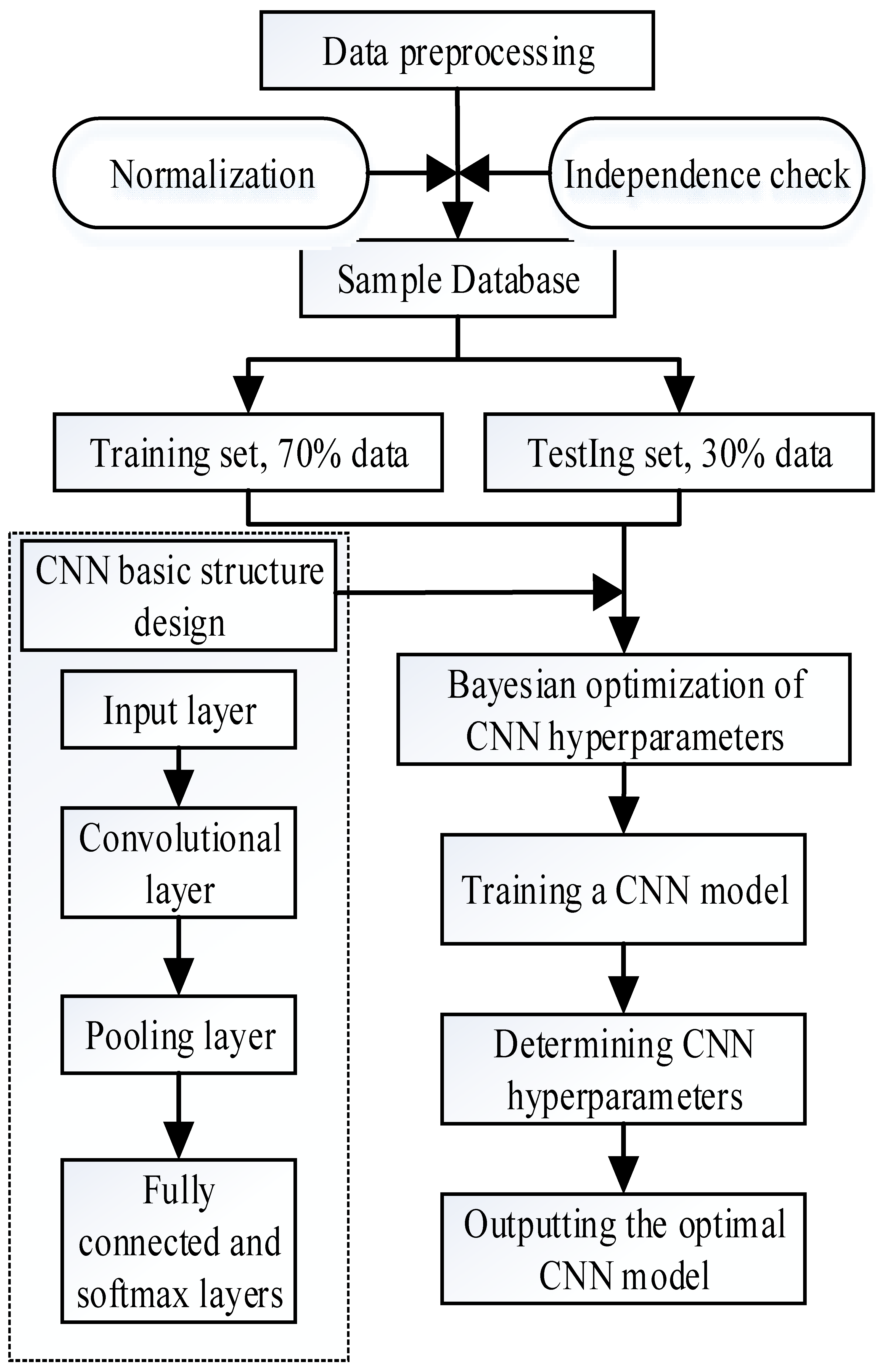
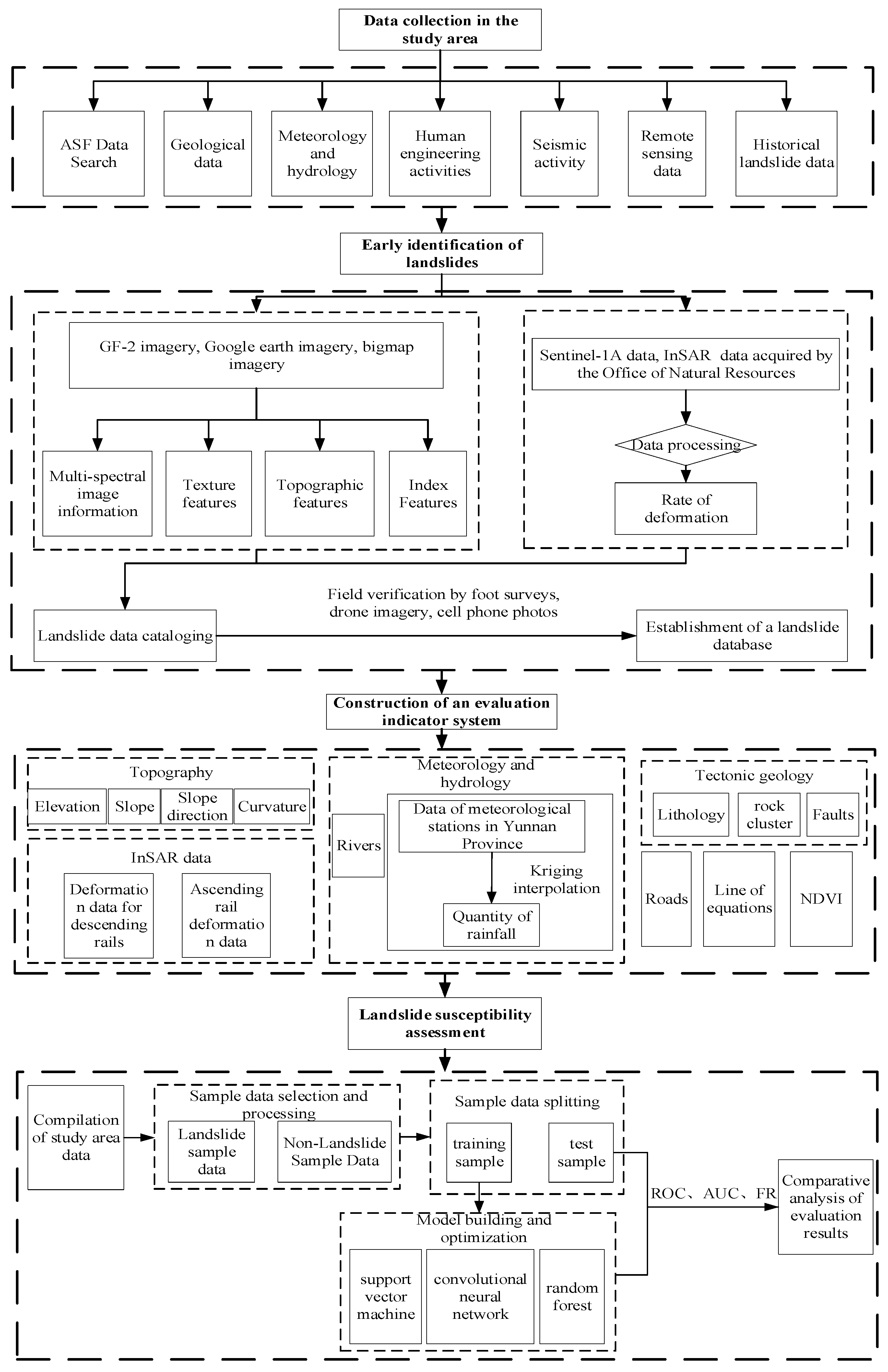

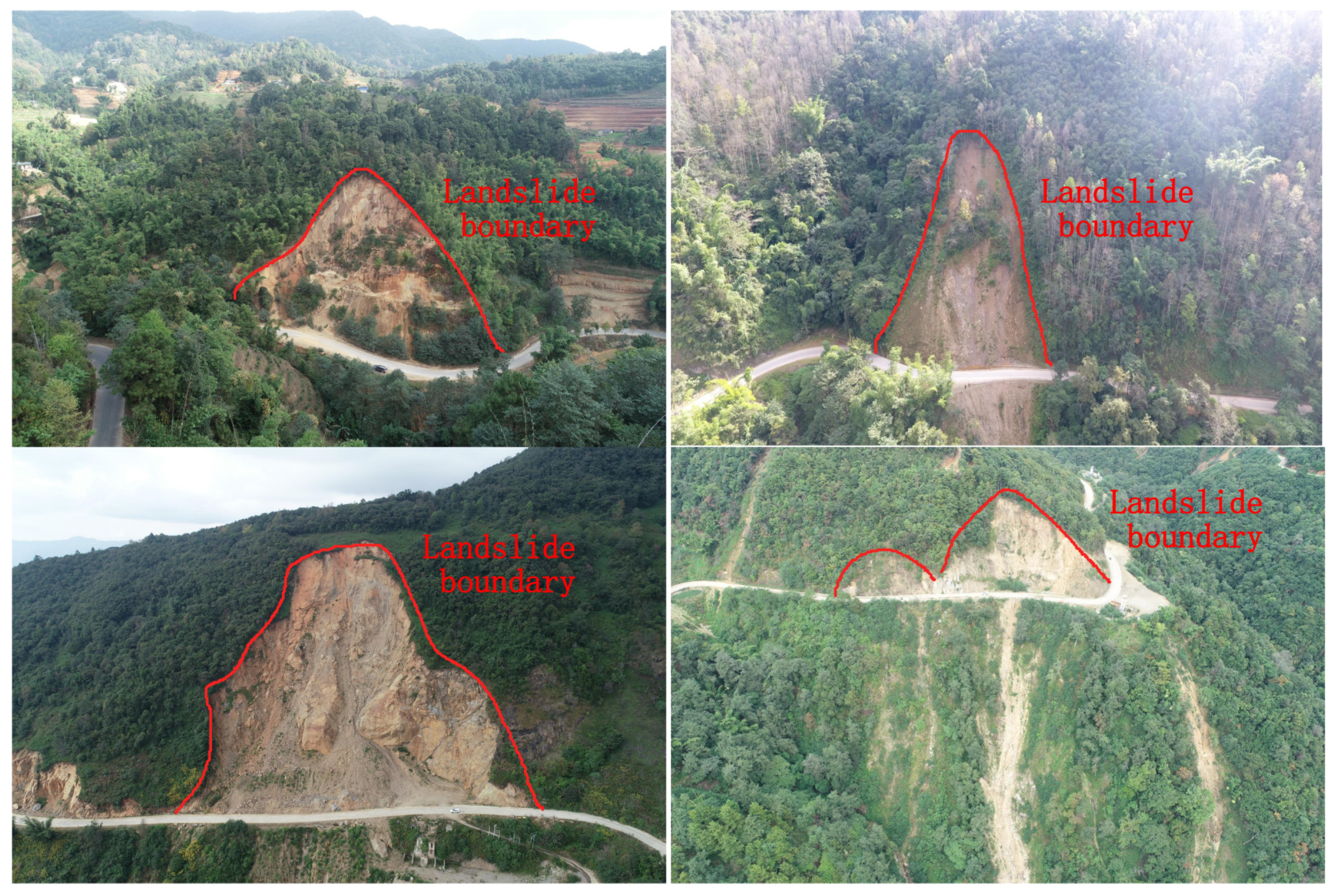
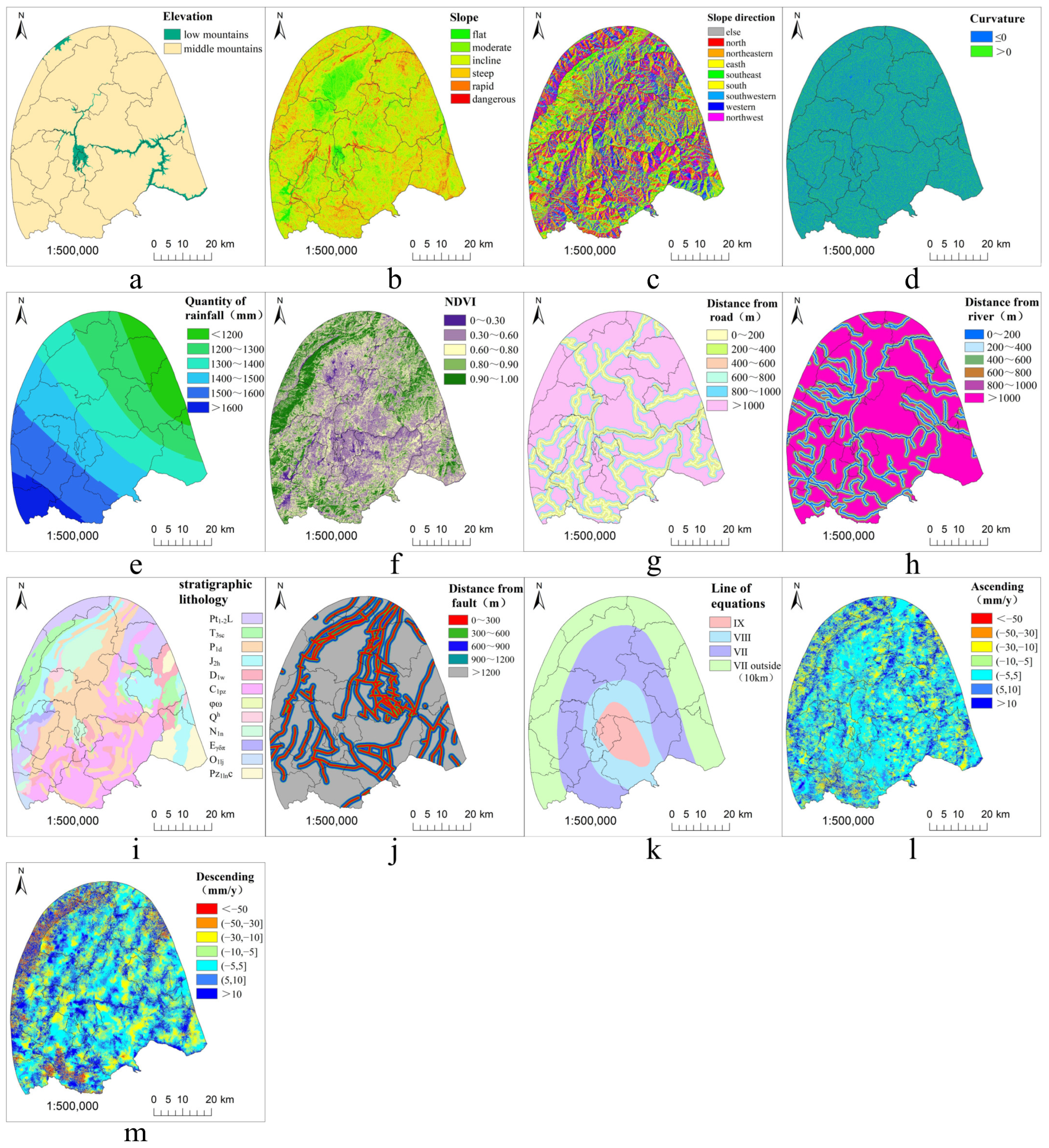
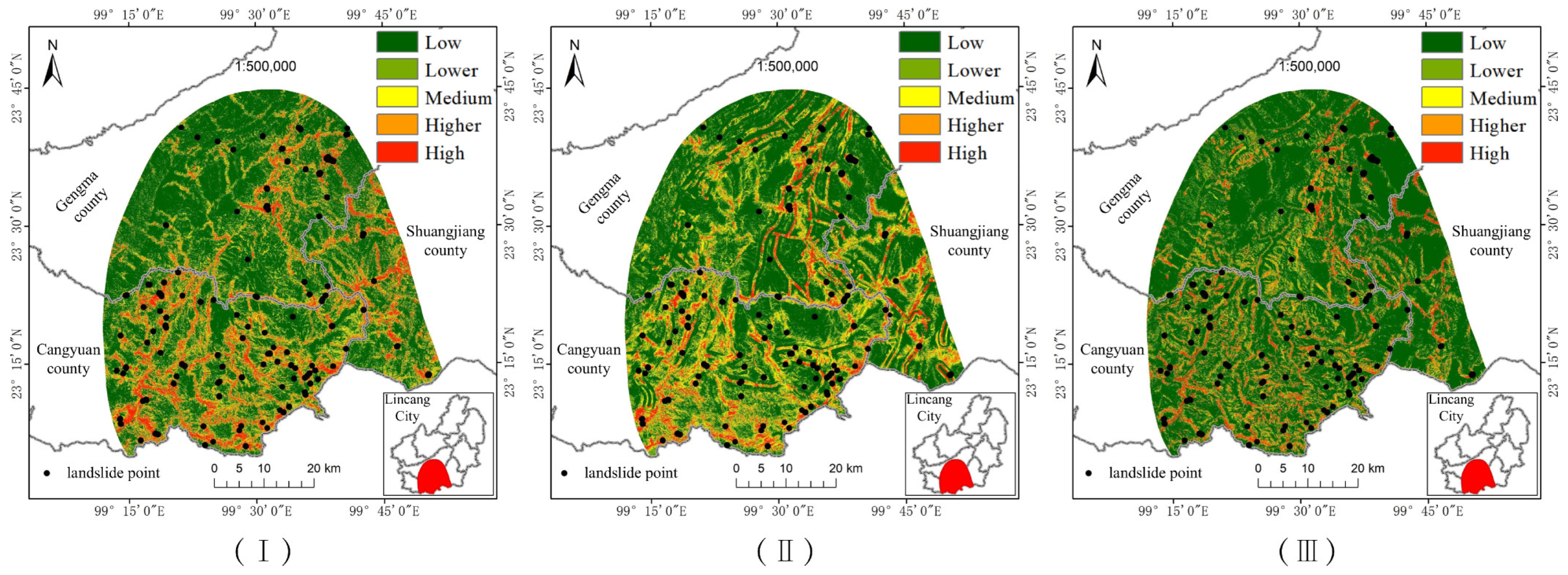
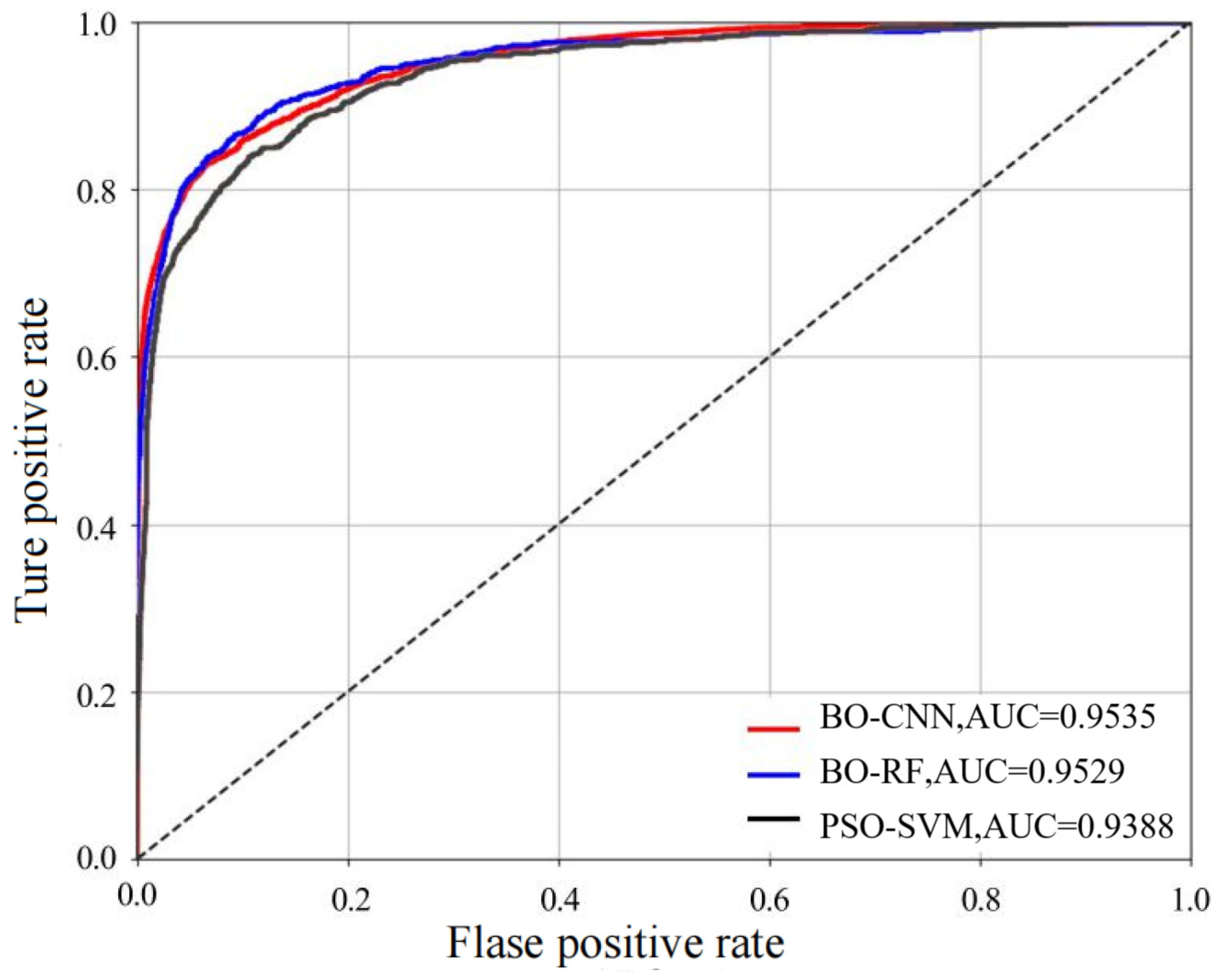

| Data Categories | Data Scale | Data Time Phase | Data Sources |
|---|---|---|---|
| DEM | 30 m | 2021 | ASTER GDEM V2 |
| Slope, slope direction, curvature | 30 m | 2021 | Elevation data acquisition |
| GF-2 remote sensing imagery | 1.0 m | 2020, 2021 | Yunnan Remote Sensing Center |
| Google remote sensing imagery | -- | 2018–2021 | Google Earth |
| Quantity of rainfall | 30 m | 2016–2020 | Yunnan Provincial Bureau of Statistics |
| Rivers and roads | -- | 2020 | Data from the Third National Land Survey |
| Stratigraphic lithology and faults | 1:50,000 | 2015 | Natural Resources Bureau (NRB) |
| NDVI | 30 m | 2020 | Landsat 8 data |
| Sentinel-1A data | 5 m × 20 m | 2018.7–2021.5 | European Space Agency (ESA) |
| EF | a | b | c | d | e | f | g | h | i | j | k | l | m |
|---|---|---|---|---|---|---|---|---|---|---|---|---|---|
| a | 1.00 | ||||||||||||
| b | 0.04 | 1.00 | |||||||||||
| c | 0.00 | 0.02 | 1.00 | ||||||||||
| d | 0.02 | 0.04 | 0.02 | 1.00 | |||||||||
| e | 0.03 | −0.02 | −0.04 | 0.00 | 1.00 | ||||||||
| f | 0.13 | 0.15 | −0.20 | 0.05 | −0.03 | 1.00 | |||||||
| g | 0.15 | 0.09 | 0.02 | 0.01 | −0.17 | 0.14 | 1.00 | ||||||
| h | 0.20 | −0.01 | 0.04 | 0.01 | −0.11 | 0.06 | 0.12 | 1.00 | |||||
| i | −0.10 | −0.14 | −0.04 | −0.01 | 0.09 | −0.16 | −0.12 | −0.01 | 1.00 | ||||
| j | −0.04 | −0.06 | 0.01 | 0.00 | 0.13 | −0.04 | 0.00 | −0.05 | 0.13 | 1.00 | |||
| k | 0.10 | 0.11 | −0.02 | 0.01 | −0.20 | 0.15 | 0.12 | −0.01 | −0.09 | 0.01 | 1.00 | ||
| l | −0.11 | 0.04 | 0.04 | −0.01 | 0.01 | −0.09 | −0.02 | −0.12 | 0.02 | 0.01 | −0.03 | 1.00 | |
| m | 0.01 | 0.03 | −0.04 | 0.01 | 0.01 | 0.02 | −0.02 | 0.01 | −0.01 | 0.00 | 0.01 | 0.03 | 1.00 |
| Evaluation Factors | Classification | Type | Nij | Sij | Sij/S | Nij/N | FR |
|---|---|---|---|---|---|---|---|
| Elevation | low mountains | continuous | 147,862 | 52 | 3.76% | 5.07% | 1.35 |
| middle mountains | 3,783,952 | 973 | 96.24% | 94.93% | 0.99 | ||
| Slope | flat | continuous | 179,825 | 1 | 4.57% | 0.10% | 0.02 |
| moderate | 903,278 | 95 | 22.97% | 9.27% | 0.40 | ||
| incline | 1,543,192 | 340 | 39.25% | 33.17% | 0.85 | ||
| steep | 1,018,128 | 334 | 25.89% | 32.59% | 1.26 | ||
| rapid | 245,035 | 184 | 6.23% | 17.95% | 2.88 | ||
| dangerous | 42,356 | 71 | 1.08% | 6.93% | 6.43 | ||
| Slope direction | Else | continuous | 10,215 | 0 | 0.26% | 0.00% | 0.00 |
| north | 487,498 | 15 | 12.40% | 1.46% | 0.12 | ||
| northeastern | 485,069 | 114 | 12.34% | 11.12% | 0.90 | ||
| east | 500,801 | 117 | 12.74% | 11.41% | 0.90 | ||
| southeast | 509,367 | 186 | 12.96% | 18.15% | 1.40 | ||
| south | 482,217 | 123 | 12.26% | 12.00% | 0.98 | ||
| southwestern | 517,237 | 240 | 13.16% | 23.41% | 1.78 | ||
| western | 479,561 | 121 | 12.20% | 11.80% | 0.97 | ||
| northwest | 459,849 | 39 | 11.70% | 3.80% | 0.33 | ||
| Curvature | ≤0 | continuous | 2,365,223 | 647 | 60.16% | 63.12% | 1.05 |
| >0 | 1,566,591 | 378 | 39.84% | 36.88% | 0.93 | ||
| Quantity of rainfall | <1200 mm | continuous | 396,165 | 223 | 10.08% | 21.76% | 2.16 |
| 1200~1300 mm | 853,043 | 242 | 21.70% | 23.61% | 1.09 | ||
| 1300~1400 mm | 962,239 | 114 | 24.47% | 11.12% | 0.45 | ||
| 1400~1500 mm | 806,605 | 230 | 20.51% | 22.44% | 1.09 | ||
| 1500~1600 mm | 692,583 | 115 | 17.61% | 11.22% | 0.64 | ||
| >1600 mm | 221,179 | 61 | 5.63% | 5.95% | 1.06 | ||
| NDVI | 0~0.30 | continuous | 170,370 | 113 | 4.33% | 11.02% | 2.54 |
| 0.30~0.60 | 1,357,292 | 535 | 34.52% | 52.20% | 1.51 | ||
| 0.60~0.80 | 1,219,988 | 238 | 31.03% | 23.22% | 0.75 | ||
| 0.80~0.90 | 471,944 | 68 | 12.00% | 6.63% | 0.55 | ||
| 0.90~1.00 | 712,220 | 71 | 18.11% | 6.93% | 0.38 | ||
| Distance from road | 0~200 m | discrete | 407,332 | 344 | 10.36% | 33.56% | 3.24 |
| 200~400 m | 333,967 | 112 | 8.49% | 10.93% | 1.29 | ||
| 400~600 m | 298,890 | 77 | 7.60% | 7.51% | 0.99 | ||
| 600~800 m | 271,858 | 50 | 6.91% | 4.88% | 0.71 | ||
| 800~1000 m | 249,179 | 37 | 6.34% | 3.61% | 0.57 | ||
| >1000 m | 2,370,588 | 405 | 60.29% | 39.51% | 0.66 | ||
| Distance from river | 0~200 m | discrete | 392,232 | 293 | 9.98% | 28.59% | 2.87 |
| 200~400 m | 367,396 | 126 | 9.34% | 12.29% | 1.32 | ||
| 400~600 m | 352,797 | 45 | 8.97% | 4.39% | 0.49 | ||
| 600~800 m | 333,975 | 125 | 8.49% | 12.20% | 1.44 | ||
| 800~1000 m | 313,162 | 56 | 7.96% | 5.46% | 0.69 | ||
| >1000 m | 2,172,252 | 380 | 55.25% | 37.07% | 0.67 | ||
| Stratigraphic lithology | Pt1-2L | discrete | 456,693 | 36 | 11.62% | 3.51% | 0.30 |
| T3sc | 364,912 | 78 | 9.28% | 7.61% | 0.82 | ||
| P1d | 969,094 | 270 | 24.65% | 26.34% | 1.07 | ||
| J2h | 453,505 | 62 | 11.53% | 6.05% | 0.52 | ||
| D1w | 254,016 | 60 | 6.46% | 5.85% | 0.91 | ||
| C1pz | 831,436 | 368 | 21.15% | 35.90% | 1.70 | ||
| φω | 4203 | 0 | 0.11% | 0.00% | 0.00 | ||
| Qh | 58,522 | 0 | 1.49% | 0.00% | 0.00 | ||
| N1n | 249,953 | 15 | 6.36% | 1.46% | 0.23 | ||
| Eγδπ | 62,648 | 116 | 1.59% | 11.32% | 7.10 | ||
| O1lj | 35,968 | 0 | 0.91% | 0.00% | 0.00 | ||
| Pz1ln | 190,864 | 20 | 4.85% | 1.95% | 0.40 | ||
| Distance from faults | 0~300 m | discrete | 517,925 | 161 | 13.17% | 15.71% | 1.19 |
| 300~600 m | 472,810 | 110 | 12.03% | 10.73% | 0.89 | ||
| 600~900 m | 416,287 | 66 | 10.59% | 6.44% | 0.61 | ||
| 900~1200 m | 362,051 | 81 | 9.21% | 7.90% | 0.86 | ||
| >1200 m | 2,162,741 | 607 | 55.01% | 59.22% | 1.08 | ||
| Line of equations | Ⅸ | continuous | 284,748 | 64 | 7.24% | 6.24% | 0.86 |
| Ⅷ | 560,974 | 96 | 14.27% | 9.37% | 0.66 | ||
| Ⅶ | 1,456,770 | 407 | 37.05% | 39.71% | 1.07 | ||
| Ⅶ outside (10 km) | 1,629,322 | 458 | 41.44% | 44.68% | 1.08 | ||
| Rate of deformation of the descending rail | <−50 mm/y | continuous | 53,117 | 2 | 1.35% | 0.20% | 0.14 |
| (−50,−30] mm/y | 98,026 | 2 | 2.49% | 0.20% | 0.08 | ||
| (−30,−10] mm/y | 632,192 | 68 | 16.08% | 6.63% | 0.41 | ||
| (−10,−5] mm/y | 558,989 | 106 | 14.22% | 10.34% | 0.73 | ||
| (−5,5] mm/y | 1,376,991 | 419 | 35.02% | 40.88% | 1.17 | ||
| (5,10] mm/y | 489,349 | 200 | 12.45% | 19.51% | 1.57 | ||
| >10 mm/y | 723,150 | 228 | 18.39% | 22.24% | 1.21 | ||
| Rate of deformation of the ascending rail | <−50 mm/y | continuous | 1534 | 5 | 0.04% | 0.49% | 12.50 |
| (−50,−30] mm/y | 28,609 | 4 | 0.73% | 0.39% | 0.54 | ||
| (−30,−10] mm/y | 489,548 | 106 | 12.45% | 10.34% | 0.83 | ||
| (−10,−5] mm/y | 528,806 | 110 | 13.45% | 10.73% | 0.80 | ||
| (−5,5] mm/y | 1,851,891 | 475 | 47.10% | 46.34% | 0.98 | ||
| (5,10] mm/y | 563,188 | 204 | 14.32% | 19.90% | 1.39 | ||
| >10 mm/y | 468,238 | 126 | 11.91% | 12.29% | 1.03 |
| Parameters | Note | Parameters | Note |
|---|---|---|---|
| kernel | RBF | c1 | 1.3 |
| C | 1 | c2 | 1.5 |
| gamma | 0.02 | ω | 0.6 |
| number of PSO | 50 | wV | 1 |
| frequency | 200 | wP | 1 |
Disclaimer/Publisher’s Note: The statements, opinions and data contained in all publications are solely those of the individual author(s) and contributor(s) and not of MDPI and/or the editor(s). MDPI and/or the editor(s) disclaim responsibility for any injury to people or property resulting from any ideas, methods, instructions or products referred to in the content. |
© 2023 by the authors. Licensee MDPI, Basel, Switzerland. This article is an open access article distributed under the terms and conditions of the Creative Commons Attribution (CC BY) license (https://creativecommons.org/licenses/by/4.0/).
Share and Cite
Deng, Y.; Zuo, X.; Li, Y.; Zhou, X. Landslide Susceptibility Evaluation of Bayesian Optimized CNN Gengma Seismic Zone Considering InSAR Deformation. Appl. Sci. 2023, 13, 11388. https://doi.org/10.3390/app132011388
Deng Y, Zuo X, Li Y, Zhou X. Landslide Susceptibility Evaluation of Bayesian Optimized CNN Gengma Seismic Zone Considering InSAR Deformation. Applied Sciences. 2023; 13(20):11388. https://doi.org/10.3390/app132011388
Chicago/Turabian StyleDeng, Yunlong, Xiaoqing Zuo, Yongfa Li, and Xincheng Zhou. 2023. "Landslide Susceptibility Evaluation of Bayesian Optimized CNN Gengma Seismic Zone Considering InSAR Deformation" Applied Sciences 13, no. 20: 11388. https://doi.org/10.3390/app132011388
APA StyleDeng, Y., Zuo, X., Li, Y., & Zhou, X. (2023). Landslide Susceptibility Evaluation of Bayesian Optimized CNN Gengma Seismic Zone Considering InSAR Deformation. Applied Sciences, 13(20), 11388. https://doi.org/10.3390/app132011388





